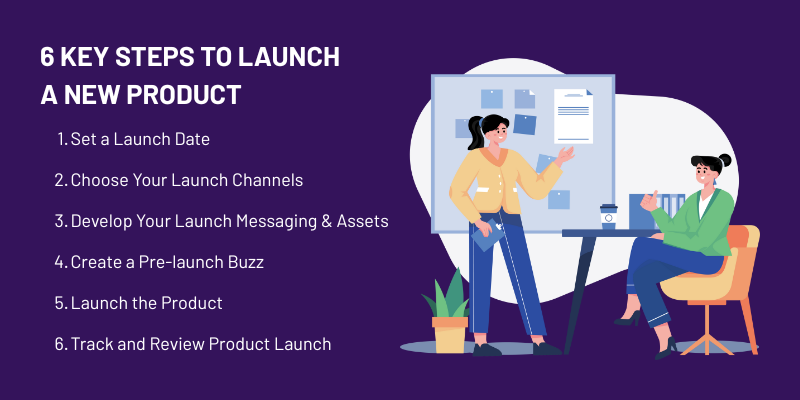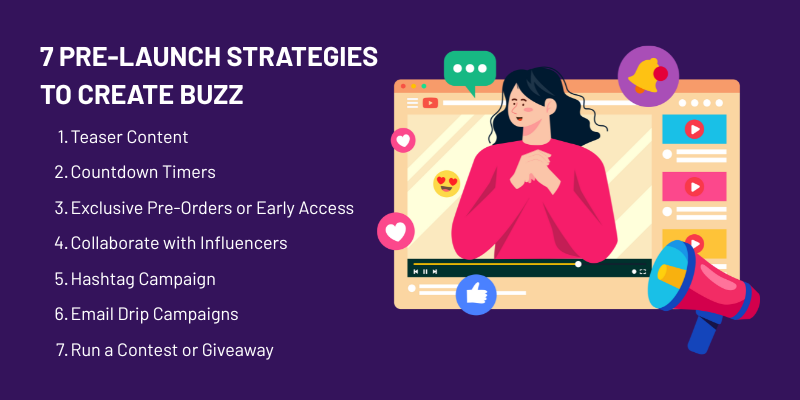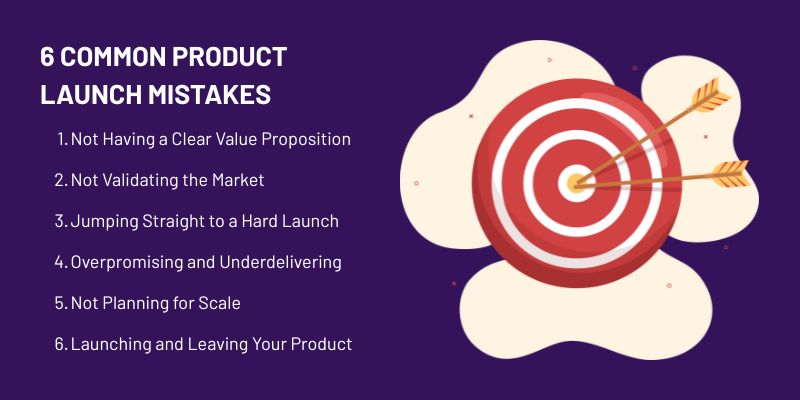Are you wondering how to launch a new product? Launching a new product is a pivotal moment for any business. It marks the culmination of extensive research, development, and strategic planning. But why is a well-executed product launch important? A successful launch can significantly impact a product's market position, customer perception, and long-term success.
Growth marketing plays a crucial role here, focusing on scalable tactics that increase customer acquisition and retention, directly impacting the new product launch's success. A well-executed product launch helps establish your product's market position and differentiate it from competitors. A successful launch can generate buzz and excitement, attracting early adopters and influencers who can help spread the word about your new product release.
Additionally, it can boost your brand's reputation and credibility by delivering high-quality items and services with compelling product features that meet or exceed customer expectations. This can lead to positive reviews, referrals, and repeat business. Moreover, a successful product launch can significantly affect a team's revenue and growth. A strong launch can drive initial sales and set the stage for ongoing demand. Ahead, you’ll learn six steps for a product launch that helps you sell out on day one.
What is a Product Launch?
A product launch is the process of introducing a completed product to the market, transitioning from a concept or prototype to something ready for consumer use.
It involves collaboration between teams across product development, marketing, sales, and operations to create a strategic go-to-market plan. This strategy not only generates demand but also maintains momentum well beyond the initial release. New Product Development Process is critical here, ensuring that the product is refined, meets market needs, and is backed by a well-thought-out launch strategy.
Releasing a new product provides an opportunity to engage with both loyal customers and new prospects. A successful launch captures attention, builds excitement, and drives urgency, ensuring continued interest in the product.
Why is Product Launch Important?
A successful product launch is no longer optional, it's essential. With increasing competition and AI accelerating product discovery, the way you launch can determine whether your product succeeds or fails.
For instance, what are five marketing strategies that retailers spend half of their annual budget on? These strategies often include digital marketing, paid advertising, content marketing, social media outreach, and influencer marketing, all crucial for a product launch.
Here are four data-backed reasons to prioritize your product launch:
- High Risk: Most product launches fail, but following a proven checklist can significantly increase the likelihood of success and turn your launch into a commercial hit.
- Intensified Competition: Nearly all (95%) consumer product executives consider new product introductions a top priority for 2025, according to Deloitte’s Consumer Products Industry Outlook. Your launch needs to stand out in an overcrowded market.
- Increasing Budgets: 80% of executives plan to increase spending on product innovation in 2025. A weak launch wastes valuable resources and money.
- Misalignment Hurts Momentum: 85% of go-to-market teams report regular misalignment between sales, marketing, and R&D, which leads to slower launches and missed revenue opportunities.
Explore Our Digital Marketing Services!
6 Key Steps to Launch a New Product
To successfully launch a new product, conduct thorough market research, define clear product positioning, develop a comprehensive go-to-market strategy, assemble a dedicated launch team, and execute a well-coordinated launch plan.

- Set a Launch Date
- Choose Your Launch Channels
- Develop Your Launch Messaging and Assets
- Create a Pre-launch Buzz
- Launch the Product
- Track and Review Product Launch
Let’s explore each:
1. Set a Launch Date
Your launch date serves as the foundation of your entire plan. It's the key milestone that guides your progress, helping you map out marketing copy, create assets, and track important deadlines.
Here’s a reverse timeline to help you stay on track:
- T-12 weeks: Finalize product positioning and the creative brief.
- T-8 weeks: Approve the MVP for beta or soft launch.
- T-4 weeks: Finalize product assets and copy.
- T-1 week: Begin distributing press releases and cue paid ads.
Using a project management tool like Asana ensures that all team members can stay aligned with deadlines and track progress in real-time.
When setting your launch date, make sure it aligns with Product Launch Checklist elements to avoid last-minute rushes.
Selecting your launch date carefully is essential for maintaining momentum, avoiding unnecessary delays, and ensuring your product actually reaches the market.
2. Choose Your Launch Channels
Your product launch channels include both the platforms you already use to engage with customers and any new channels where your target audience is active or expects to hear from you.
Furthermore, ensure consistency with your branding guidelines, which will help maintain a cohesive and professional image across all your marketing channels.
Leverage your most effective marketing channels for the launch.
Here are some to consider:
- SMS: If you’re active on SMS, its directness can break through the clutter of crowded inboxes and social media feeds.
- Email: Email allows you to craft a personal message about your product. It’s measurable, helping you track engagement and interest. A timely announcement email with a link to a preorder page is a simple yet powerful launch tool.
- Social Media: Identify where your audience expects updates from you. These platforms are excellent for building excitement and momentum, creating buzz around your product.
- In-person Events: Hosting a booth at events like farmers markets or street fairs lets people interact with your product directly, creating memorable experiences and opportunities for face-to-face engagement.
- Influencer Marketing: Collaborating with influencers expands your reach and builds trust, allowing your audience to see your product in real-life scenarios and reducing potential barriers to purchase.
3. Develop Your Launch Messaging and Assets
Before you dive into creating marketing materials, take a step back and answer these key questions:
- How will you position this product in the market?
- What tone will your taglines and copy have?
- How will your messaging differ across various channels?
- How many emails, text messages, social media posts, and blog entries do you plan to create?
- Are you planning to invest in advertising?
- Are your product descriptions engaging and exciting?
Once you have clarity on these questions, the next step is to focus on high-quality product photography.
These decisions are crucial for Product Advertising and determining how to present your product effectively across multiple channels. High-quality photography and compelling copy will drive engagement and sales.
It’s also essential to work closely with a digital marketing services provider to ensure your messaging and assets are optimized for the digital landscape.
If professional photography is outside your budget, don’t worry, you can still capture great images yourself. Just remember, these visuals are often the first impression potential customers will have of your product, so make sure they stand out.
Choosing the right visuals and crafting compelling copy will require effort, but it’s essential. The right assets can significantly enhance your launch’s success, grabbing attention and driving action.
4. Create a Pre-Launch Buzz
Creating a pre-launch buzz is crucial for generating excitement and anticipation around your upcoming product.

Effective strategies include influencer collaborations, teaser content, and countdown timers. A luxury branding agency can help here by ensuring your product resonates with high-end consumers, setting the stage for a successful launch with an exclusive appeal.
Additionally, collaborating with Centric, a digital transformation agency, can enhance your overall pre-launch strategy by leveraging cutting-edge technology and customer engagement tactics.
Here's a comprehensive guide to effective strategies:
-
Teaser Content
Post cryptic or close-up images, behind-the-scenes videos, or product hints to generate curiosity. Keep it mysterious to spark speculation and conversations.
-
Countdown Timers
Display countdowns on your website and social media to remind followers of the approaching launch. It adds excitement and urgency.
-
Exclusive Pre-Orders or Early Access
Offer limited-time pre-orders or exclusive early access to a select group. This creates a sense of exclusivity and drives early commitment.
-
Collaborate with Influencers
Partner with influencers who align with your brand. They can create buzz by sharing sneak peeks and excitement with their followers.
-
Hashtag Campaign
Create a catchy, unique hashtag for your product launch and encourage followers to use it. It helps spread the word and builds a community around the product.
-
Email Drip Campaigns
Send a series of teaser emails leading up to the launch. Gradually reveal new product details, keeping your audience engaged and eager for more.
-
Run a Contest or Giveaway
Host a giveaway or contest where participants can win early access or exclusive discounts. This encourages sharing and expands your reach.
These strategies, when executed well, will generate significant buzz and anticipation for your upcoming product.
5. Launch the Product
When it’s time to launch your product, everything you’ve worked toward culminates in this moment. A successful product launch doesn’t just happen, it’s the result of careful planning, strategic execution, and engaging your audience at the right time.
This is the moment where your product is no longer a concept, but a reality that your customers can experience.
To ensure your product launch goes smoothly, consider the following key actions:
-
Announce the Launch
Make a clear, impactful announcement via all your launch channels. Let your audience know the product is officially available for purchase, pre-order, or access.
-
Leverage Social Media
Post regularly about the product launch, including product features, benefits, and exclusive deals. Use engaging visuals, videos, and stories to capture attention.
-
Press Release & Media Coverage
Issue a press release or secure media coverage to spread the word beyond your immediate audience. This can significantly amplify visibility.
-
Launch Promotions & Discounts
Offer limited-time discounts, bundles, or exclusive launch offers to encourage immediate sales. Make it something people can’t miss out on.
-
Monitor and Respond
Actively monitor customer feedback, social media mentions, and any issues. Respond quickly to questions, concerns, or praise to maintain positive engagement.
-
Celebrate the Launch
Don’t forget to celebrate with your team, partners, and customers. Share your excitement and gratitude, reinforcing the connection with your brand.
Once the launch is underway, your focus should be on building momentum, keeping communication open, and staying engaged with your audience to ensure lasting success.
A well-executed launch sets the stage for long-term customer relationships and continued product success.
6. Track and Review the Results
After you launch a product, it’s time to dive into your platform analytics to assess what worked and what didn’t. This post-launch analysis is critical for fine-tuning your strategy and guiding future product launches.

Key product launch metrics to track include traffic, conversion rates, social engagement, and how to measure awareness in marketing, which will indicate how well your target audience is responding to your campaign.
Key product launch metrics to track:
-
Traffic and Sessions
These metrics indicate how effective your pre-launch buzz was in driving visitors to your site. If traffic is lower than expected, consider increasing paid spend or re-sending your SMS/email campaigns to re-engage potential customers.
-
Conversion Rate
The conversion rate shows how successful your landing page, product offer, and checkout process were at persuading visitors to make a purchase. If the conversion rate is low, consider adjusting your messaging, adding social proof, or optimizing your checkout flow with options like Shop Pay.
-
Revenue Per Channel
This metric tracks which marketing channels drove the most sales. By identifying the highest-performing channels, you can adjust your budget to maximize ROI during launch week.
-
Social Engagement (Likes, Shares, Comments)
Social engagement metrics help you gauge how well your product launch resonated with your audience. More engagement indicates stronger interest and excitement, which is key for ongoing success.
-
Customer Acquisition Costs (CAC)
Tracking your CAC provides valuable insights into the efficiency of your marketing and sales efforts. A lower CAC suggests a good product-market fit and higher customer satisfaction.
By monitoring these metrics, you can gain a deeper understanding of your product's performance, refine your strategy, and set a stronger foundation for future launches.
Key Considerations and Questions for a Successful Product Launch
Launching a product involves several crucial steps that need careful planning and execution. To ensure success, it is essential to consider factors such as market research, branding, sales enablement, and product testing, among others. This expanded Product Launch Success Matrix will help you assess all key dimensions of the launch, from preparation to post-launch strategies.
| Launch Dimension | Key Considerations | Questions to Ask |
|---|---|---|
| Market Research | Understanding customer needs, market gaps, and competitor analysis | Have you validated your product concept with real users? Are there existing solutions? |
| Branding & Messaging | Crafting a compelling value proposition and consistent messaging | Does your messaging clearly communicate the product's benefits? Is it tailored to your target audience? |
| Go-to-Market Strategy | Defining distribution channels, pricing strategy, and promotional tactics | Have you identified the most effective channels to reach your audience? Is your pricing competitive? |
| Sales Enablement | Equipping sales teams with the right tools and training | Do your sales teams have the necessary resources to sell the product effectively? |
| Customer Support Readiness | Preparing support teams for potential customer inquiries and issues | Are your support teams trained to handle questions and problems related to the new product? |
| Performance Metrics | Establishing KPIs to measure launch success and areas for improvement | What metrics will you track to gauge the success of your launch? How will you collect and analyze feedback? |
6 Common Product Launch Mistakes and How to Avoid Them
To ensure your product launch is a success, steer clear of these common pitfalls:

1. Not Having a Clear Value Proposition
Poor positioning and unclear messaging can undermine even the best products. Develop a clear value proposition and A/B test different messaging during your soft launch. Only use the top-performing copy for the full launch.
2. Not Validating the Market
If there isn’t a market for your product, your launch will falter. Ensure you know exactly who will buy your product and at what price point. This validation is crucial before going live.
3. Jumping Straight to a Hard Launch
Avoid going straight into a full launch. Start with a limited launch or crowdfunding campaign to validate demand. Aim for a target of 300 orders or sign-ups before moving to a hard launch.
4. Overpromising and Underdelivering
While product differentiation is essential, avoid making inflated claims. Delaying the launch until the product is fully ready can prevent disappointments. Conduct thorough product testing to ensure your claims are accurate and can drive purchasing decisions.
5. Not Planning for Scale
If your product takes off, you need a plan to scale production quickly. You never know when a viral moment, like a TikTok trend, can wipe out your inventory. Be prepared to handle an unexpected surge in demand.
6. Launching and Leaving Your Product
The launch doesn’t end once your product is live. Schedule a 24-hour retrospective with your team, implement a seven-day improvement plan, and engage with early buyers to collect product reviews.
By avoiding these mistakes, you can set your product up for long-term success and growth.
FAQs: How to Launch a New Product?
What is the first step in launching a new product?
The first step in how to launch a product is conducting market research to understand customer needs, market gaps, and competitors. This helps position your product and ensures it aligns with your target audience’s expectations.
How do you create a successful product launch plan?
A successful new brand launch plan includes defining goals, outlining marketing strategies, and preparing your team for customer support. Align your plan with clear messaging to ensure smooth execution.
What are the best strategies for promoting a new product?
Effective strategies for the launch of new product include social media marketing, email campaigns, influencer partnerships, and paid advertising. These methods help build buzz and drive traffic to your product.
How do you measure the success of a product launch?
Measure success by tracking KPIs like sales volume, customer feedback, website traffic, and social media engagement. Use analytics to evaluate performance and adjust strategies for the how to launch new product in market process.
How do you prepare your team for a product launch?
Prepare your team by training them on product features, messaging, and handling customer inquiries. Ensure clear communication and coordination across all teams for smooth execution.
Conclusion
Careful planning ensures that every element, from market research and product development to marketing strategies and team coordination, is thoroughly organized for product launch. Taking a comprehensive approach to how to launch a new product minimizes risks and maximizes the chances of a positive market reception. By addressing each stage in detail, businesses can ensure that pre-launch, launch, and post-launch activities are executed smoothly, setting the stage for a strong introduction to the market. However, launching is just the beginning. Continuous improvement after the launch is crucial to maintain momentum and adapt to changing market demands. By actively gathering customer feedback, monitoring key performance metrics, and making iterative enhancements, businesses can refine both their product and strategy. This dedication to ongoing improvement not only enhances customer satisfaction but also positions the product for long-term success in the marketplace.








